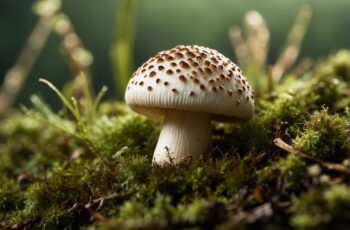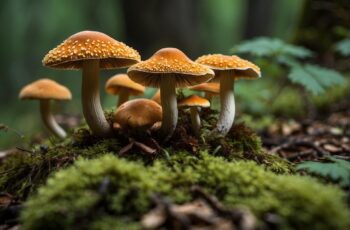Mushroom hunting, an engaging activity for nature enthusiasts and culinary adventurers alike, becomes especially intriguing during a rainfall. As you pull on your boots and grab your basket, you’ll find the woods transforming under the patter of raindrops, creating a prime environment for fungal treasures to emerge. The moist conditions provided by rain showers are particularly favorable for the growth of mushrooms, making post-rain forays into the forest potentially rewarding.

Navigating the wet, earthen paths with keen eyes, you’re partaking in a tradition that dates back centuries. More than a mere hobby, foraging for mushrooms in the rain requires skill and knowledge, as the damp earth not only nourishes a variety of mushrooms but also challenges you with slippery trails and obscured visibility. It’s a pursuit that demands both physical readiness and mental sharpness, as some mushrooms are as elusive as they are delicious.
Key Takeaways
- Rainfall creates optimal conditions for mushroom emergence.
- Preparation and safety are crucial for a successful rain-based forage.
- Proper identification is essential to reap the full rewards of your hunt.
Preparing for the Hunt
Mushroom hunting after the rain can yield a bountiful harvest, provided you’re well-prepared with the right knowledge and gear.
Understanding the Environment
In North America, from the coniferous forests of the Pacific Northwest to the hardwoods of the Midwest, different environments host varied species of wild mushrooms. Spring typically offers prime conditions with increased rain and mild temperatures that cause mushrooms to flourish. Soil temperature and moisture are crucial; morels, for instance, appear as the soil warms to about 45-50 degrees Fahrenheit. Be aware of the specific ecosystems you are exploring, whether you’re at higher elevations in the mountains or in the damp woods of the East Coast.
- Hardwood forests: Look for morels near elms, ash, and aspens, typically in disturbed ground.
- Coniferous forests: Chanterelles and pine mushrooms often surface amongst pines and firs.
Essential Equipment
Prepare to navigate through nature with the right tools. A basket or mesh bag allows for sustainable harvesting, enabling spores to spread and promote future growth.
- Mushroom field guide: To identify edible from poisonous mushrooms.
- GPS or compass: To ensure you don’t lose your way in unfamiliar woods.
- Pocket knife: For clean cuts to harvest mushrooms without damaging them.
- Whistle: For personal safety, especially if you’re hunting alone.
Remember to wear appropriate clothing for hiking in wet conditions and consider bringing a small toolkit with essentials like water, snacks, and a first-aid kit.
Safety and Regulations
Safety is paramount, and being informed about local regulations will ensure both your well-being and the conservation of wild food sources.
- Always confirm whether you’re on private land or public land and understand the permissions required to forage in these areas.
- Learn to recognize toxic mushroom varieties to avoid harmful mistakes.
- Follow rules and regulations of sustainable harvesting, which include not overharvesting and avoiding sensitive ecological areas.
By respecting nature and preparing adequately, your foraging trip not only becomes safer but also helps to preserve the joy of mushroom foraging for foragers across Canada and the United States for years to come.
Identifying and Locating Mushrooms
When embarking on mushroom hunting, your ability to identify and locate mushrooms is critical. Knowledge of tree associations, recognizing edible species, and reading nature’s signs can lead to successful foraging.
Tree Associations
Mushrooms often have symbiotic relationships with certain trees. Morels, for instance, favor hardwood forests and are frequently found near ash, elm, sycamore, and apple orchards. Developing your tree identification skills can significantly increase your chances of locating these prized fungi.
- Ash Trees: Look for a diamond-patterned bark.
- Elm Trees: Identify them by their unique, asymmetrical leaf bases.
- Sycamores: Notice the mottled, exfoliating bark.
Familiarity with hickory and other hardwoods can also be advantageous, as various edible mushrooms thrive in their vicinity.
Recognizing Edible Species
Identifying edible mushrooms involves examining characteristics like cap shape, color, size, gills, and spore prints. For example, the ever-popular morel has a distinctive honeycomb cap, while chanterelles are known for their bright, golden color.
- Morels: Honeycomb cap with a hollow interior.
- Chanterelles: Golden hue with wavy margins and false gills.
Remember, always consult reputable mushroom identification resources before consuming any wild fungi.
Reading the Signs of Nature
Nature offers hints for when and where mushrooms may appear. Morels, for instance, pop up in the spring, often in areas with moist soil and after snowmelt. They can be prolific after rainfall, as moisture prompts the fruiting body to emerge.
- Soil Moisture: Check the soil dampness by taking note of the foliage and nearby water sources like river bottoms.
- Weather Patterns: Track rainfall and temperature shifts after winter, particularly during snowmelt periods, as these conditions can stimulate fungal growth.
Paying attention to these clues provided by nature can lead to fruitful mushroom foraging adventures.
Harvesting and Post-hunting Practices
When you return from the rain-soaked woods with your basket full of morels, proper techniques in harvesting and post-hunting practices are crucial to maximize the quality and safety of your wild edibles.
Sustainable Harvesting Techniques
Harvesting mushrooms in a sustainable way ensures that you leave behind a healthy ecosystem for future foraging. When collecting morels, it’s best to cut the stems with a sharp knife rather than pulling the mushrooms out of the ground. This method preserves the underground mycelium, which is essential for future crops. Keep your morels in a woven basket or a mesh bag; this helps to disperse spores as you continue foraging.
- Cut the stem: Use a knife to avoid damage to mycelium.
- Basket/Mesh Bag: Helps spread spores for new mushrooms.
Cleaning and Storage
Once home, the first step is to clean your morels. Gently brush off any debris with a soft brush and rinse them quickly under cool running water if necessary. Morels have a honeycomb-like cap that can trap debris, so it’s important to inspect and clean them thoroughly. For storage, wrap the morels in a paper towel and store them in a paper bag within the refrigerator. This method of storage helps to keep them dry and extends their freshness for a few days.
- Clean gently: Brush and quick rinse.
- Store properly: In a paper bag with a paper towel in the refrigerator.
Culinary Applications
Morel mushrooms are highly praised by chefs and enthusiasts for their nutty and earthy flavors, making them a sought-after ingredient in many recipes. Sauté them in butter to bring out their natural flavors, or incorporate them into sophisticated dishes like morel risotto or creamy pastas. Always cook morels before consumption, as they can be toxic when raw. The versatility of these mushrooms allows for a broad range of culinary applications, from a simple preparation to being featured in the finest restaurant menus.
- Cook thoroughly: Sauté in butter or use in dishes.
- Explore recipes: From risottos to pastas.
Enhancing Mushroom Foraging Knowledge

Enhancing your knowledge about mushroom hunting is crucial for safe and successful foraging. Understanding mushroom ecology and having the right educational resources at your disposal can significantly enrich your experience.
Learning Resources
To become proficient in mushroom hunting, the first step is educating yourself. Use:
-
Mushroom Field Guides: Books by experts like David Arora provide detailed information on identifying various wild mushrooms. “Mushrooms Demystified” and “All That the Rain Promises and More” are indispensable resources that cover mushroom varieties, hunting techniques, and safety tips.
-
Online Platforms: Websites such as Mushroom Observer offer extensive databases and identification tools. For visual learners, YouTube channels dedicated to foraging can be extremely insightful, offering step-by-step guides and firsthand experiences from seasoned foragers.
Connecting with the Foraging Community
Joining a community can greatly enhance your foraging skills:
-
Local Foraging Groups: Connect with fellow mushroom enthusiasts through local groups or clubs. Sharing knowledge and experiences can help you learn faster.
-
North American Mycological Association (NAMA): Becoming a member of NAMA puts you in touch with a network of mycologists and foragers. They offer forays, which are organized outings during the hunting season, particularly useful for beginners to learn about morel mushroom hunting in a safe environment.
Remember, foraging for wild mushrooms can be risky; proper education and community support can ensure you enjoy mushroom hunting while staying safe.


